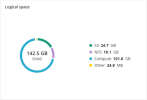Logical space chart
The Logical space chart represents all the space allocated to different services for storing user data. This includes the space occupied exclusively by user data. Replicas and erasure coding metadata are not taken into account.
How logical space is calculated
When monitoring disk space information in the cluster, keep in mind that logical space is the amount of free disk space that can be used for storing user data in the form of data chunks and all their replicas. Once this space runs out, no data can be written to the cluster.
To better understand how logical disk space is calculated, consider the following example:
- The cluster has three disks with the storage role. The first disk has 200 GB of space, the second one has 500 GB, and the third one has 1 TB.
- If the redundancy mode is set to three replicas, each data chunk must be stored as three replicas on three different disks with the storage role.
In this example, the available logical disk space will be 200 GB, that is, equal to the capacity of the smallest disk with the storage role. The reason is that each replica must be stored on a different disk. So once the space on the smallest disk (that is, 200 GB) runs out, no new chunk replicas can be created unless a new disk with the storage role is added or the redundancy mode is changed to two replicas.
With the two replicas redundancy mode, the available logical disk space would be 700 GB, because the two smallest disks combined can hold 700 GB of data.
How compute and iSCSI logical space is calculated
Block storage space used by iSCSI LUNs and compute volumes is not fully thin provisioned. Though storage space is not allocated when you create a block volume, the volume usage grows on demand and cannot be reduced. In this case, used logical space is the space actually used by data. At most, used logical space can reach the volume size. After user data removal, unused storage space is not reclaimed and is reported as actual used space.
To better understand how compute and iSCSI logical space is calculated, consider the following example:
- A user creates an iSCSI LUN with 100 TB.
- The user connects the LUN to VMware as a datastore.
- The user fills up this datastore with data/VMs. The used logical space grows to 100 TB.
- The user deletes the data, emptying the datastore. But the block storage space is not reclaimed and the used logical space remains 100 TB.
